Leaves rustled in a walking rhythm, a hint that a buck was headed my way. Weeks of unseasonably warm weather had the freshly fallen leaves as crispy as Corn Flakes, and the sound of a buck on the prowl was unmistakable. I’d been grunting periodically which probably lured the deer toward my location. A few days ahead of the rut, this buck was aggressive.
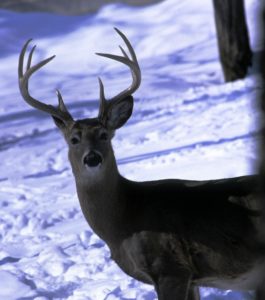
The hoof steps grew continually louder, and I finally got a glimpse of the deer and a large flash of white well above its ears. The buck was locked in on my grunts, no doubt eager to tangle with lesser animals, when it suddenly stopped and turned sharply uphill. I had shot a doe half an hour earlier, and I suspected the blood from the carcass spooked it.
As the deer moved uphill, I grunted loudly yet it had no effect. Grabbing a rattling bag from my pack, I crashed it wildly and saw the buck stop, still barely visible at 100 yards. I crashed the pine planks again, grunted, and the buck took several steps toward me. I grunted and it moved closer, then stopped and scanned my direction for the sight of deer.
Luckily I was in a tree stand above a dense patch of greenbriers and a buck fight could easily happen out of sight. Again the animal took a few steps and stopped, a signal that it was time to wait and not allow it to further pinpoint my location. As with wild turkeys and elk, once an animal has committed, let it approach without further calling.
As the buck closed to 75 yards, I could see wide sweeping beams well beyond its ears with a 10-inch brow tine. I knew not to look at its antlers, yet couldn’t resist as it repeatedly searched and listened. Finally, the buck approached an opening where I could get a solid reading. The rangefinder said 45 yards, a long shot, yet I’d just killed a doe at 32 and the Excalibur bow was dead on. Resting the bow on the stand’s shooting rail, I watched the buck step into the opening, mouth-grunted to stop it, and misread the scope reticles, shooting at 35 instead of 45 yards. The arrow passed just under its chest, buried into the earth, and spooked the buck back up the hill. No amount of coaxing would turn it.
The Power of the Grunt
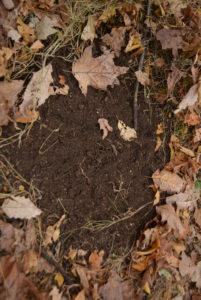
Bill McKinley found himself in a similar situation two days earlier as he watched a buck follow a doe into the woods 100 yards out. With the deer moving away, McKinley gave a single grunt on his tube, causing the buck to stop, turn, and come directly toward him. McKinley killed the buck at 15 yards and it barely went out of sight.
If these two anecdotes haven’t convinced you to use a grunt tube, consider the buck I saw just after daylight. It moved along the opposite side of the ravine. I gave several grunts and the animal turned, walked down a steep slope, splashed across a stream at the bottom, and walked to within five yards. The young 1.5-year-old didn’t meet the Quality Deer Management (QDM) standards of the club, or my hunt would have ended right there.
Rattling
Rattling doesn’t often work, yet it only has to once (unless you miss). The advantage of
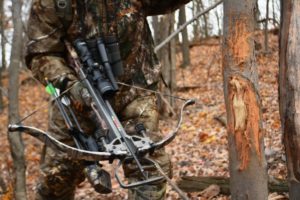
rattling comes from the distance it can be heard. During the pre-rut, bucks are often on the prowl, and banging antlers or using a rattling bag every half hour or so could lure a big buck to your location that would have otherwise gone elsewhere.
Patience
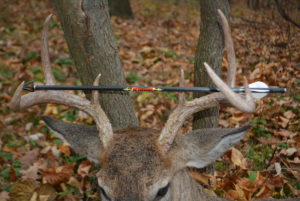
I grunted the 6-point in at 9:30, killed the doe at 2:00 and lured the big buck at 3:00 despite very warm weather. Deer movements in the early and full rut are very unpredictable, except that they move frequently during daylight hours. If you are finding does, the bucks will follow, so be patient. This is the time of the year, where it’s better to spend quantity of time on the stand. Normally the first hour of daylight is golden, yet if getting up in the wee hours burns you out for the day, follow your normal sleep cycle and be “on duty” by 8:00 with plans to spend the morning and the full day, if possible.
I checked my trail cameras in the early afternoon to avoid deer contact a few years back. On the way in, I saw smoking hot rubs and scrapes, and decided to spend an hour or two in my stand. Within 15 minutes, a 3.5-year-old buck chased several does through the area. It paused at 30 yards and I put an arrow through its chest. What a surprise!
Your best chance for the biggest buck of your season will come during the pre-rut. Make plans now to be out there. Arrange or rearrange your vacation schedule to be in the woods November 2-10. Bring the horns, your grunt tube, and pack plenty of patience.



















![The Best Deer Camp Chili [VIDEO] Deer Chili Ingredients, Tomatoes, Chili Spices](/wp-content/uploads/2015/10/Deer-Chili-Deer-Camp-Recipe-218x150.jpg)
![How to Call Elk Early in the Season [VIDEO]](/wp-content/uploads/2016/08/byers003-218x150.jpg)

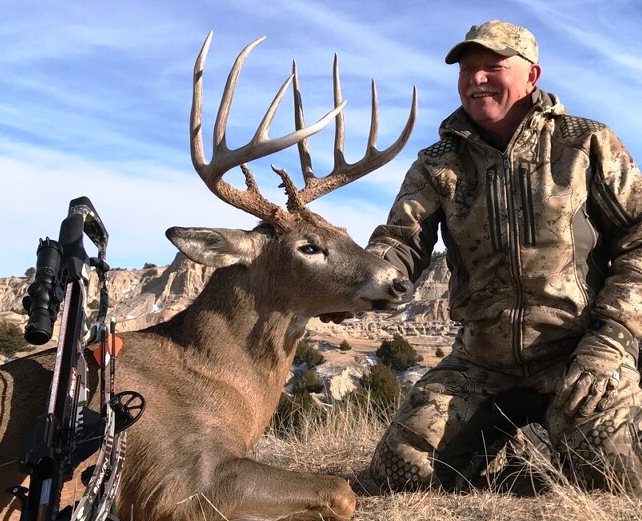


![Idiots Disturb Hunter: How Would You Have Handled It? [VIDEO]](/wp-content/uploads/2015/10/DSC00110-e1474487693878-100x70.jpg)
![Albino Buck Shocked to Shed His Antlers [VIDEO]](/wp-content/uploads/2015/10/AlbinoDeer-100x70.jpg)